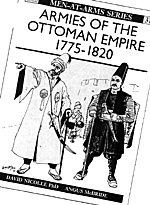 Armies of the Ottoman Empire 1775-1820,
Armies of the Ottoman Empire 1775-1820,
Osprey Men At Arms Series #314,
by David Nicolle with color plates by Angus McBride
(ISBN 1-85532-697-3)
I have been waiting for this book to be written for about six years, so, well done David Nicolle for attempting to fit such a large subject into a small book. For wargamers new to the Ottomans, but interested in raising a Napoleonic Ottoman army, this book will not stand alone as the one source you need, although that alone as the one source you need, although that is probably true of all Ospreys, nor are they intended to be the one-stop source for the budding wargamer. For experienced researchers of Ottoman armies, the plates and prints will be a useful addition, but the text is of less use.
As usual the color plates are magnificent, depicting no less than 30 figures. Of these, 10 are officers/NCO, and one is a child and another a courier, and not an Ottoman Janissary in sight! So that leaves 18 combat troop plates that are useful to the painting wargamer.
Plenty of black and white prints -- 24 alone depicting various uniforms, including Chechen infantry. Many I haven't seen before, coming as they do from French archives, even though I have seen most of the works in the bibliography. (A word of warning -- plates H3 and H4 have been transposed -- the Libyan Kuloghi is in fact H3. Also plate D has no numbering alongside the figures -- D4 is the back right, D3 is back left, D1 is front right and D2 is front left. For me personally, the various officer/chieftain plates are new, but the most useful is the Horse Artillery plate and the Egyptian Janissary plate, which are new to me.
The text has brief chapters on the people of the empire, Ottoman fragmentation, a very sketchy chronology, recruitment and ranks, and then sections on each troop type. These sections are: traditional forces (infantry, Mehter bands, cavalry, technical corps), provincial forces, the new army (Nizam-Cedit), the navy, a glossary and further reading.
Each area of the empire is covered, including the Arabs, mentioning the various troop types present, but mostly without discussion of numbers, quality or unit size.
Some of the known guard units are missed come pletely, even though one print shows some (page 5 Grand Vezir's Mamluks), the original print being available in color in one of the sources quoted. I know, I bought a copy in Turkey.
It is claimed, not unreasonably, that the Djellis were by this time the most numerous feudal irregular cavalry, but this is not quantified by numbers -- the largest number I have come across is the 5,000 sent to Egypt in 1803.
No estimates of the sizes of the provincial armies are given, nor of the proportion of the troop types involved. Understandably, such information is not easily available, nor perhaps is a fixed quantity useful when considering armies that were often raised by volunteers flocking to standards and civilians carrying guns deciding to become soldiers. It is such detail that wargamers need however!
The author does concur with my understanding of Ottoman armies, that the provincial armies were often better than the regular government armies, and that some of the best troops were light infantry (page 13). This should not be understated when producing an Ottoman army in miniature -- many of these provincial forces were trained by European renegades.
What perhaps is under emphasized is the overall view that the Ottoman army was in fact several different armies, each unique in structure and uniform type. Of this I am becoming more and more convinced, the more I read on the Ottomans. Thus describing an Ottoman Bosnian army will not describe an Ottoman Serbian, or Syrian army, for example.
To review all of these in one Osprey is a major charIenge, and on balance, to the credit of the author, a very good job has been done. This is perhaps equivalent to trying to describe all the armies of the Confederation of the Rhine in one Osprey, a task I hope no one will consider easy.
For the wargamer, some of the nitty-gritty detail is lacking, but this is to be expected in a work of this size. It is recommended that other Ospreys on the Ottomans would be required for a more complete picture.
The author dismisses the Sipahis of the Porte, or more correctly, the Suvarileri, as virtually nonexistent, whereas previous estimates put the total at 28,000 on the rolls in the 1780s. Also, he classifies the 10,000 trained lancers as Sipahis of the Porte, but then contradicts this by saying they came from provincial Sipahis. My understanding is that they came from the feudal Sipahis, rather than the Suvarileri, but either way they end up better than both. The book fails to mention provincial artillery forces, some of which were quite strong, and does not mention Yoruk light cavalry, which it was assumed were still around.
Overall a useful work, with plenty of good illustrations, but by no means the definitive or complete work on the subject.
Back to Dragoman Vol. 2 No. 4 Table of Contents
Back to Dragoman List of Issues
Back to MagWeb Magazine List
© Copyright 1998 by William E. Johnson
This article appears in MagWeb (Magazine Web) on the Internet World Wide Web. Other military history articles and gaming articles are available at http://www.magweb.com